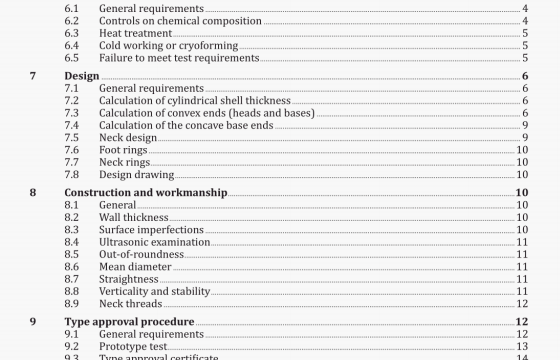ISO 9809-4 pdf download – Gas cylinders一Refillable seamless steel gas cylinders一Design, construction and testing – – Part 4: Stainless steel cylinders with an Rm value of less than 1 100 MPa.
NOTE The test method requirements are given below. Additional guidanc for these test methods and equipmentcontrol (calibration and maintenance) can be found in ISO 6406.The purchaserand manufacturer shall agree which of these alternatives shall be carried out.
— a hardness Lest in accordance with 11
— a leak test in accordance with UA
— a water capacity check in accordance with 11.5.
11.2 Hydraulic test
11.2.1 Proof pressure test
The water pressure in the cylinder shall he increased at a controlled rate until the test pressure, ph. is reached within a measuring tolerance of O/+3 % or +10 bar, whichever is lower.
The cylinder shall remain under pressure p’, for at least 30 s to establish that the pressure does not fall and that there are no leaks. During the period that the cylinder Is under test pressure, It shall be visible (including the base) and remain dry. After the test, the cylinder shall show no visible permanent deformation and no trace of moisture implying leakage.
11,2,2 Volumetric expansion test
The water pressure in the cylinder shall he increased at a controlled rate until the test pressure, Ph. is reached within a measuring tolerance of O/+3 % or +10 bar, whichever is lower.
The cylinder shall remain under pressure pt1 for at least 30 s and the total volumetric expansion measured. The pressure shall then be released and the volumetric expansion remeasured.
The cylinder shall be rejected if it shows a permanent expansion (i.e. a volumetric expansion after the pressure has been released) in excess of 10% of the total volumetric expansion measured at the test pressure. Ph
The total and permanent expansion readings shall be recorded, together with the corresponding serial numberof each cylinder tested, so that the elastic expansion (i.e. the total expansion less the permanent expansion) under the test pressure can be established for each cylinder.
11.3 Hardness test
A hardness test in accordance with ISO 6506-1, ISO 6508-1. or other equivalent methods shall be carried
out by the manufacturer. The hardness values thus determined shall be within the limits specified by
the cylinder manufacturer for the material, dependent upon the heat treatment used for the production
01 the cylinder and the intended gas service (e.g. embrittling gases).
NOTE Methods for measuring the surface indentations other than those given in ISO 6506-1 or ISO 6508-1 can be used subject to agreement between the parties concerned provided that an equal level of accuracy can be demonstrated.
11.4 Leak test
The manufacturer shall employ such manufacturing techniques and apply such tests as will demonstrate to the satisfaction of the inspector that the cylinders do not leak.
For cylinders with base ends formed by spinning, typical testing procedures include:
— pneumatic leakage test where the bottom end can be clean and free from all moisture on the test pressure side;
NOTE The inside area of the cylinder bottom surrounding the closure can be subfrctcd to a pressure equal to at least 2/3 times the test pressure of the cylinder for a minimum oil mm. This area can be not less than 20 mm in diameter around the closure and at least 6% of the total bottom area. The opposite side can be covered with water or another suitable medium and closely examined for Indication olleakage. Cylinders that leak ciln be reected
— low pressure pneumatic test;
— helium leak test.
11.5 CapacIty check
The manufacturer shall verify that the water capacity conforms to the design drawing.
12 CertIfication
Each batch of cylinders shall be covered by a certificate signed by the inspector to the effect that the cylinders meet the requirements of this part of ISO 9809 In all respects. An example of a suitably worded certificate is given in Annci.D.
Copies of the certificate shall be issued to the manufacturer. The original certificate shall be retained by the inspector and the copies by the manufacturer in accordance with the regulations of the relevant statutory authority.
13 Marking
Each cylinder shall be permanently marked on the shoulder, or on a reinforced part of the cylinder or on a permanently fixed collar or neck ring, in accordance with ISO 13769 or the relevant marking regulations of the countries of use.
NOTE Attention is drawn to the requirements for marking in relevant regulations that might override the requirements given in this International Standard.
ISO 9809-4 pdf download – Gas cylinders一Refillable seamless steel gas cylinders一Design, construction and testing – – Part 4: Stainless steel cylinders with an Rm value of less than 1 100 MPa
